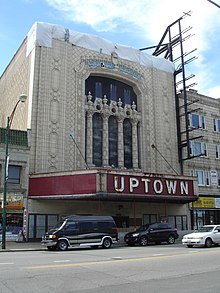Rapp and Rapp
| C. W. & George L. Rapp | |
|---|---|
| Practice information | |
| Key architects | C. Ward Rapp; George L. Rapp; Mason G. Rapp |
| Partners | C. Ward Rapp; George L. Rapp |
| Founded | 1906 |
| Dissolved | 1965 |
| Location | Chicago, Illinois |



C. W. & George L. Rapp, commonly known as Rapp & Rapp, was an American

The named partners were brothers C. Ward Rapp (1860–1926) and George L. Rapp (1878–1941), sons of a builder and natives of
Biographies and history
Cornelius Ward Rapp was born December 26, 1860. In the 1880s he moved to Chicago, where he worked for architect Cyrus P. Thomas. In 1889, the two formed the partnership of Thomas & Rapp.[1] This was dissolved in 1895, when both opened independent offices. Rapp's major projects over the next eleven years included Altgeld Hall (1895–96) and Wheeler Hall (1903–04) at what is now Southern Illinois University Carbondale and the Coles County Courthouse (1898–99) in Charleston.[2] His father was superintendent of construction for both Carbondale buildings.[3] Rapp was an independent practitioner until 1906, when he formed a partnership with his younger brother, George L. Rapp.[4]
George Leslie Rapp was born February 16, 1878. He was educated in the
Legacy
The Rapp brothers were among a group of highly influential American theatre architects, which also included
Many of the theatres and other buildings designed by the Rapp brothers have been listed on the United States National Register of Historic Places.
Buildings
Some of the notable buildings that the firm designed include:
Chicago, Illinois
- Central Park Theatre
- Chicago Theatre
- Gateway Theatre, now Copernicus Center
- Hotel Windermere
- Jackson Shore Apartments
- New Bismarck Hotel, today "Hotel Allegro"[6]
- Old Dearborn Bank Building, also known as 203 North Wabash Street[7]
- Oriental Theatre, now James M. Nederlander Theatre
- Palace Theatre
- Riviera Theatre
- Tivoli Theatre
- Uptown Theatre
Other areas
- Denver, Colorado
- Paramount Theatre
- Orpheum Theater
- The Majestic Theatre
- Orpheum Theatre
- Miller Theater (1922-1972)
- Leland Hotel
- Michigan Theatre
- St. Louis, Missouri
- Ambassador Theatre (demolished)
- St. Louis Theater(now Powell Hall)
- Loew's Jersey Theater
- Middletown, New York
- Paramount Theatre, Brooklyn
- Paramount Theatre, Times Square
- Kings Theatre, Brooklyn (formerly Loew's Kings Theater)
- Cincinnati, Ohio
- Palace Theatre (demolished)
- Cleveland, Ohio
- Palace Theatre
- Warner Theatre (now DeYor Performing Arts Center)
- Akdar Theatre 1922-1964
- Paramount Theatre (now Arlene Schnitzer Concert Hall)
- Pittsburgh, Pennsylvania
- Loew's Penn Theatre(now Heinz Hall)
- Loew's State Theatre, now the Providence Performing Arts Center
- Paramount Theater
- Seattle, Washington
- Paramount Theatre
- Al. Ringling Theater
- Milwaukee, Wisconsin
- Bradley Symphony Center, formerly the Warner Grand Theater
- Modjeska Theater
- Uptown Theatre (demolished)
- Wisconsin Theater (demolished)
- Gateway Theatre, now the Rhode Center for the Arts
- RKO Main Street Theatre
References
- ^ "Personal" in Building 10, no. 4 (January 26, 1889): 32.
- ^ Coles County Courthouse NRHP Registration Form (1978)
- ^ Daniel B. Parkinson, A Historical Bulletin of the Southern Illinois State Normal University (Carbondale, 1914)
- ^ a b c d Richard W. Longstreth and Steven Levin, "Rapp and Rapp" in Macmillan Encyclopedia of Architects 3, ed. Adolf K. Placzek (New York: Free Press, 1982): 532.
- ^ "Deaths" in AIA Journal 67, no. 9 (August, 1978): 77.
- ^ At La Salle Street / Randolph Street / Wells Street. The German architect Albert Eitel worked together with Rapp and Rapp at the facade design and was responsible for the interior design of the hotel. House builders were Emil, Karl and Otto K. Eitel stemming from Germany. See: New Bismarck-Hotel in Chicago. Moderne deutsche Einrichtungskunst in Amerika. In: Innendekoration 38.1927, Seite 254-272.
- ^ Virgin Hotel Phorio
Further reading
- Charles Ward Rapp, Rapp & Rapp, Architects (2014)
External links
![]() Media related to Rapp & Rapp at Wikimedia Commons
Media related to Rapp & Rapp at Wikimedia Commons
- Theatre Historical Society of America
- History of Chicago's Uptown Theatre
- Friends of the Uptown
- Balaban and Katz
- Friends of the Loew's (Jersey Theatre)
- Rialto Square Theater Official Website[permanent dead link]
- 203 North Wabash building website[permanent dead link]
- Rapp and Rapp at archINFORM
- Hotel Warner website
- Louis Grell Foundation/
- Architectural records for buildings by Rapp & Rapp, (ca. 1911-1971 (bulk 1911-1959)), held by the Chicago History Museum
